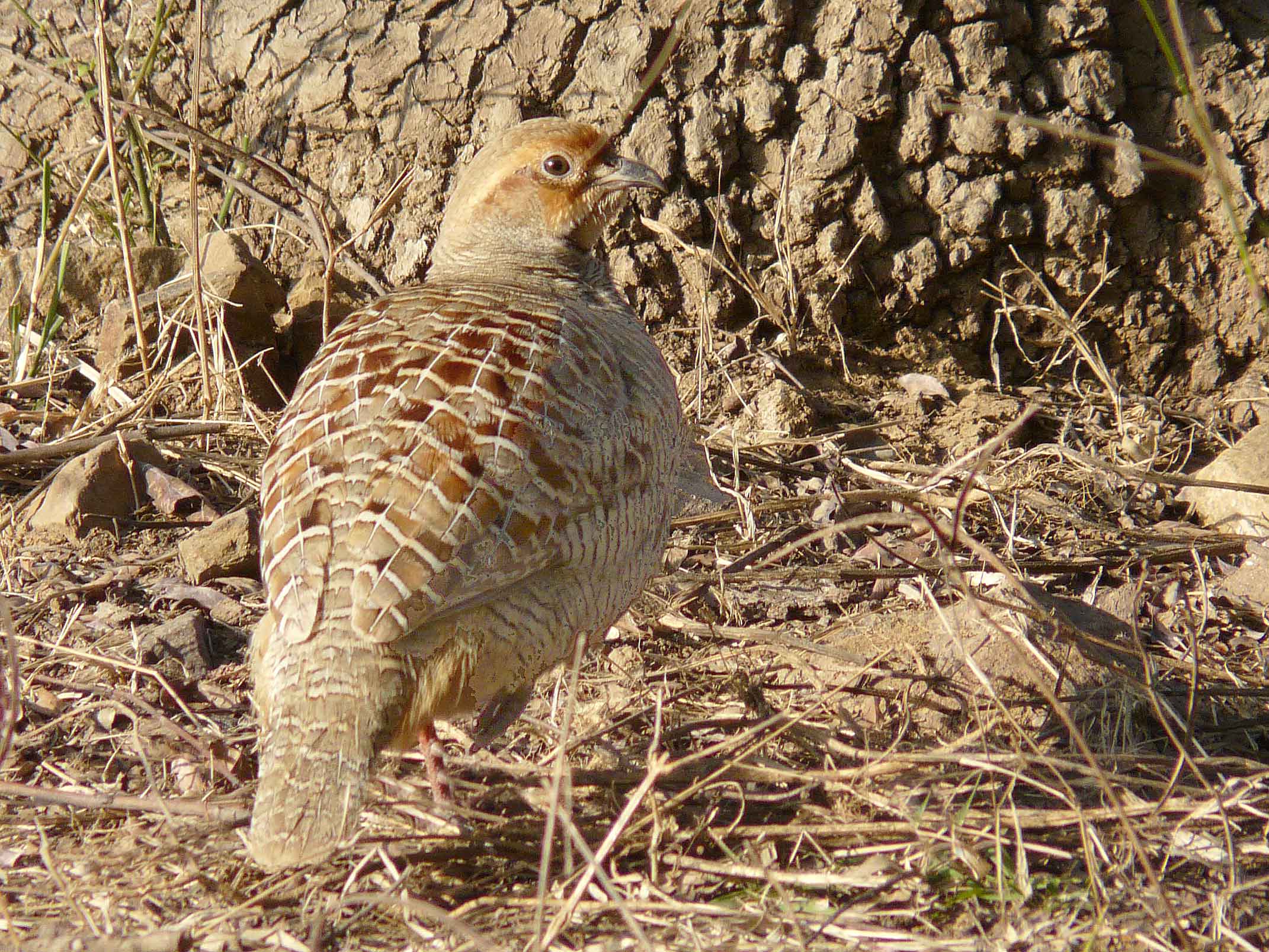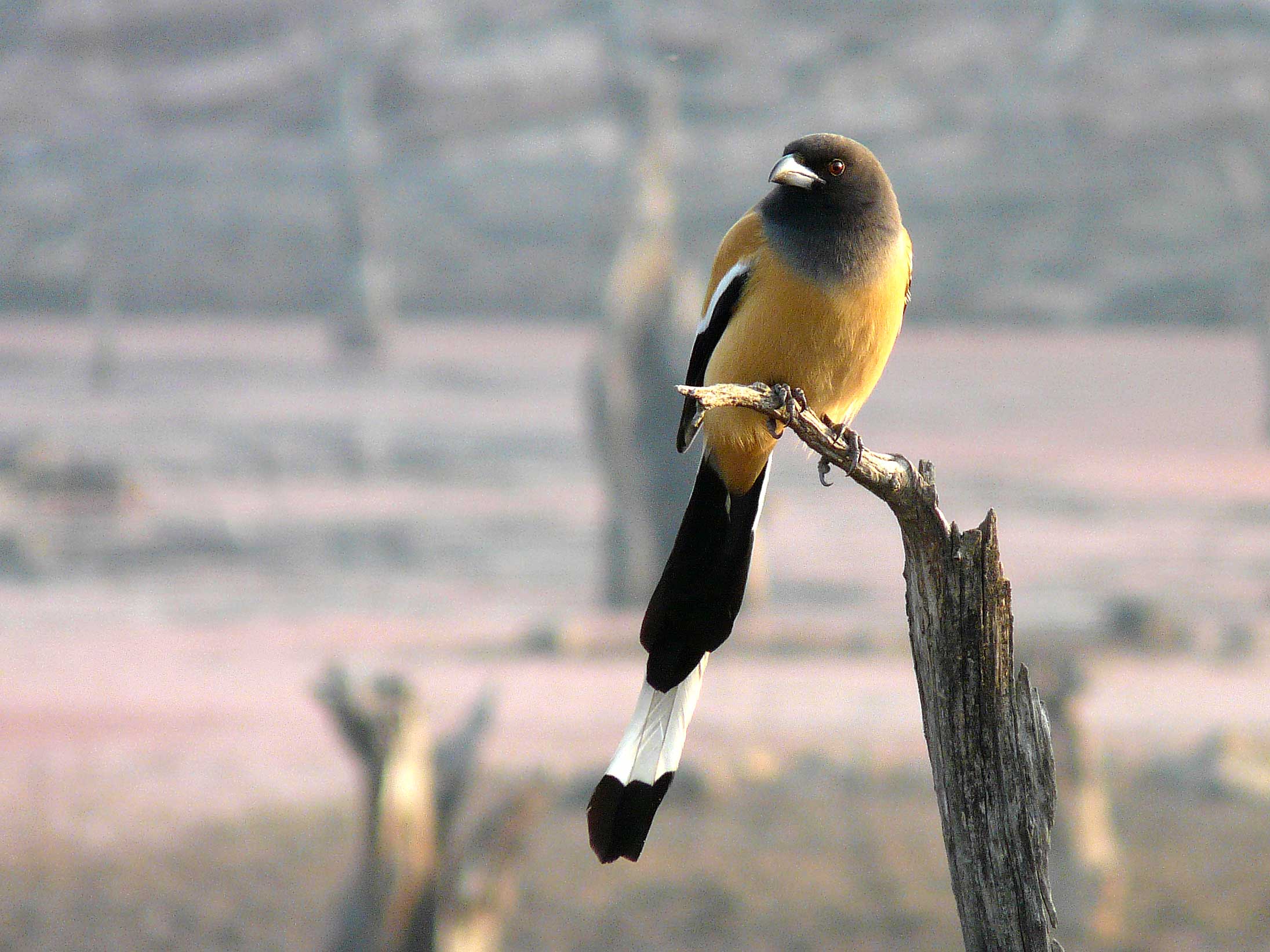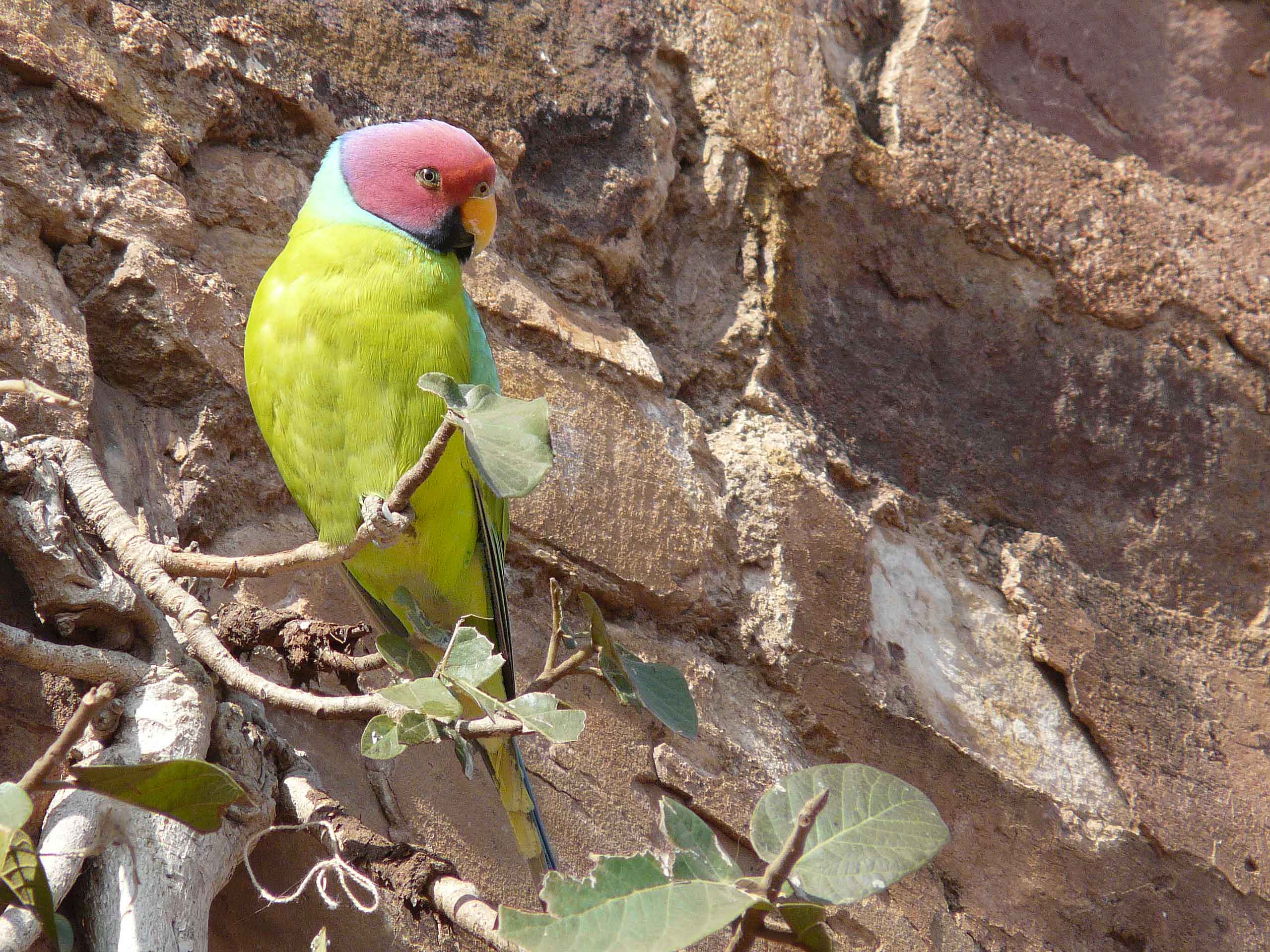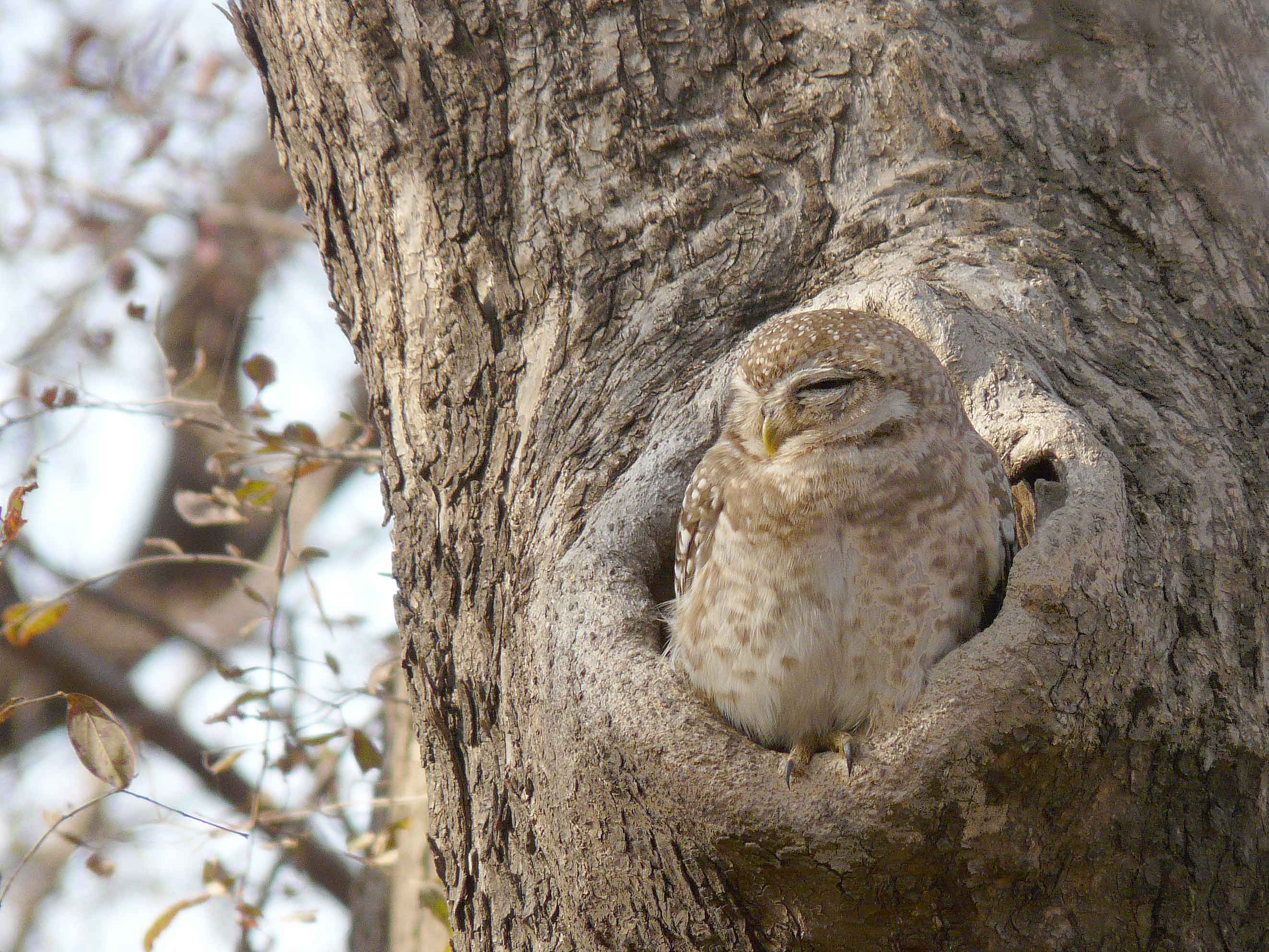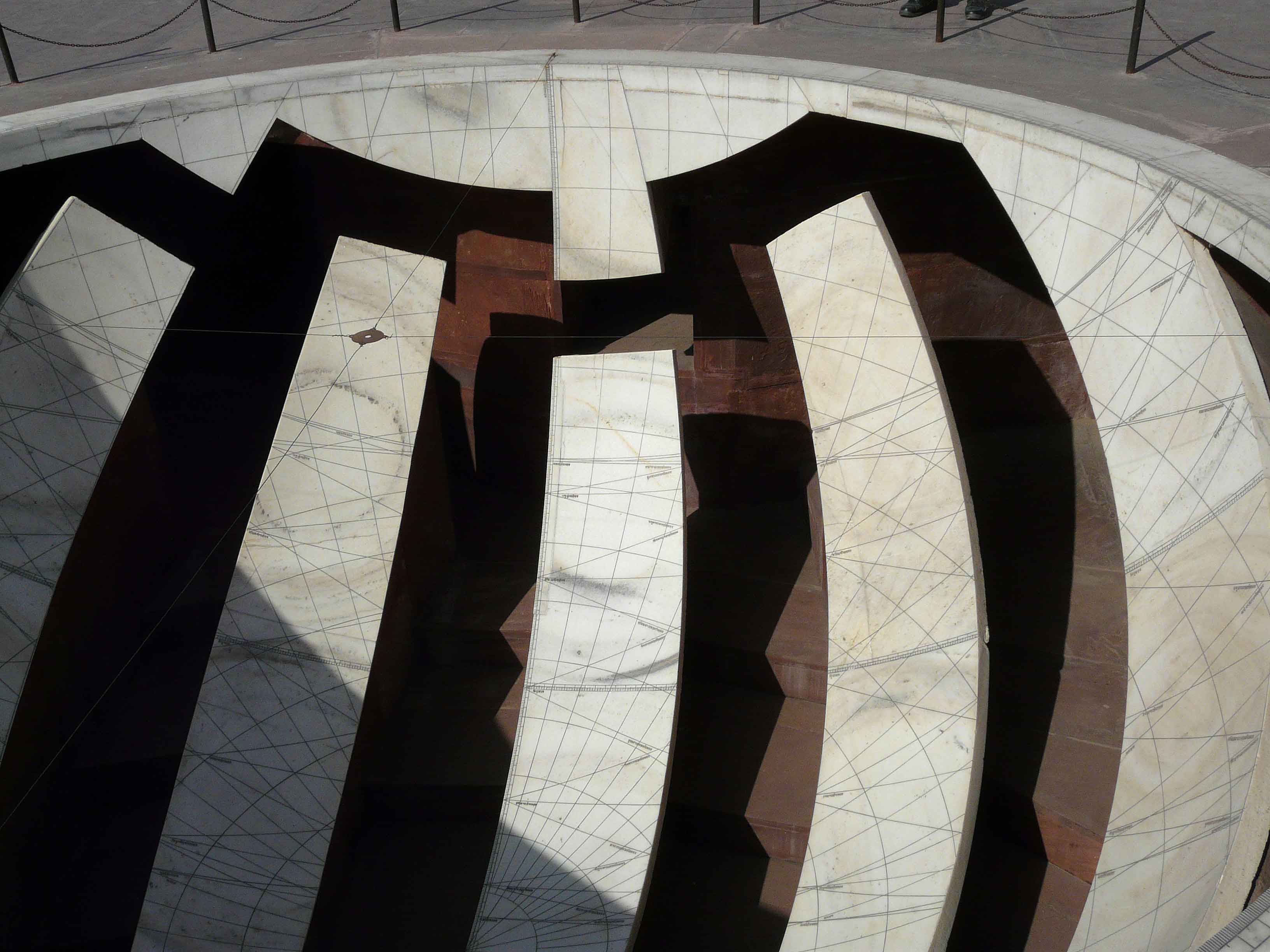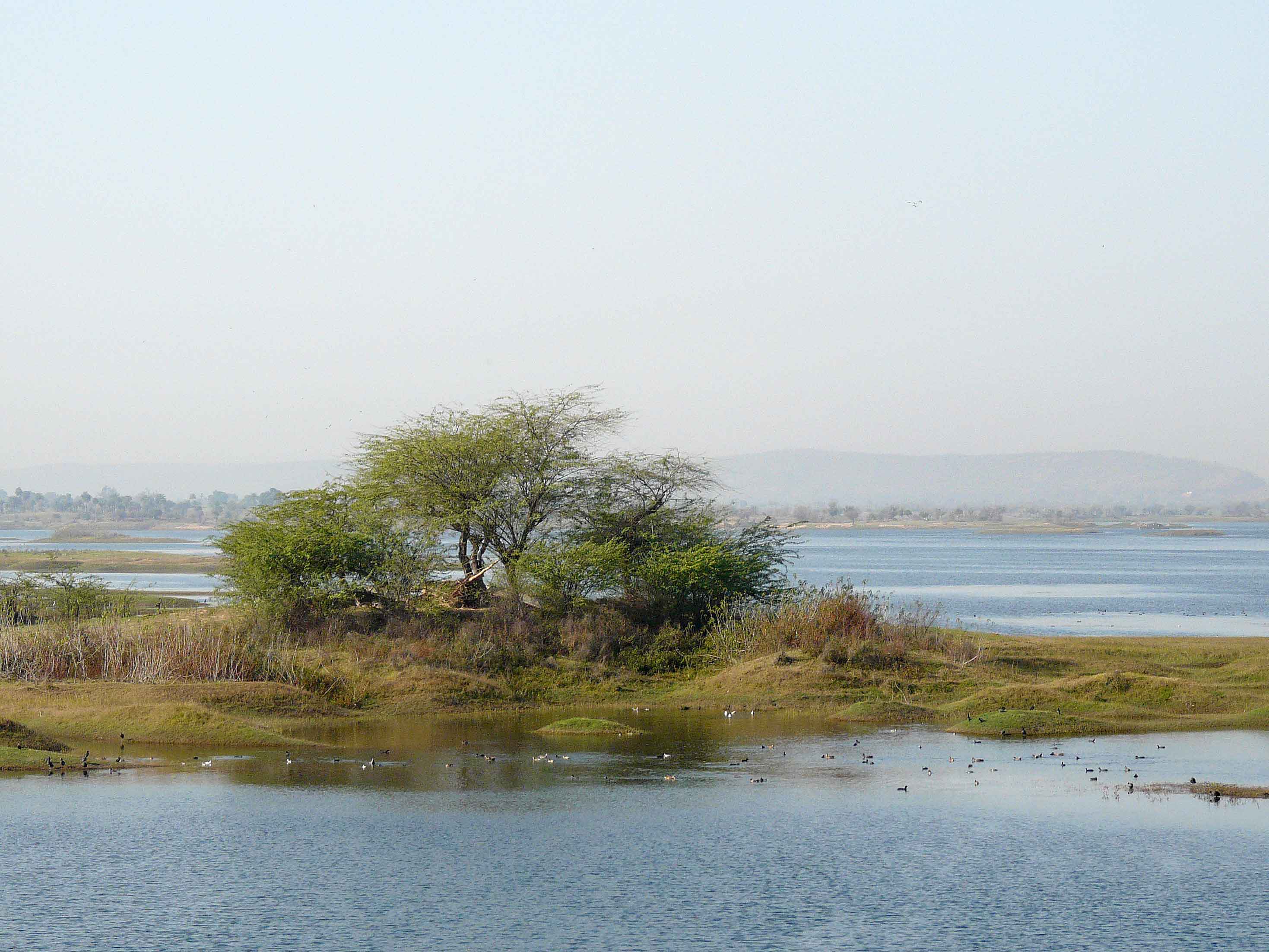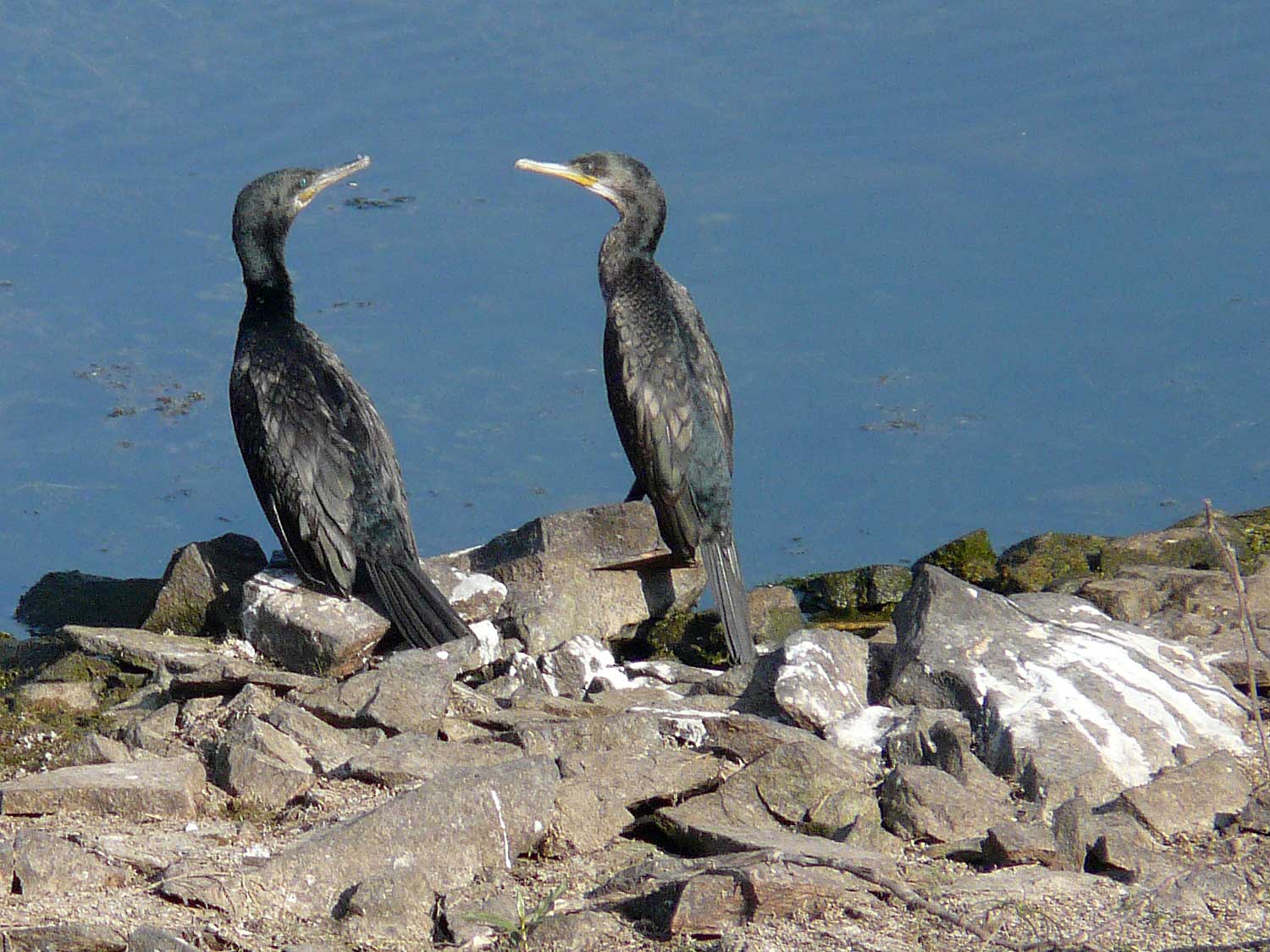 Northern
India
Trip
Report
Northern
India
Trip
Report

25 January - 17 February 2010
Part
2: 01-07 February, 2010
(click here for
Part 1)
(click
here
for
Part 3)
Day 08 -
February 01, Monday: Jodhpur to Ranthambhor NP
We caught the train to Ranthambhor at 0555 hours, arriving at 1315
hours. After checking into our hotel (Tiger Moon Resort)
we
took
an
afternoon
drive
into
the
park
for
tiger
tracking.
Ranthambore National Park is one
of the largest and most famous national parks in northern India, but
what a change since I was there in 1989. Hotels and lodges have
multiplied, as have the number and variety of vehicles entering into
the park every day to look for tigers. The tigers, on the other
hand, have not multiplied, and there are now perhaps fewer than 20
remaining, a decline caused by inept park management, an inability to
police the park and prevent poaching, and the uncontrolled increase in
eco-tourism development around the park (of which our group was now
part of the problem). A sad situation. As only a partial
consolation there are still plenty of birds and other wildlife in the
park.
Unsurprisingly we struck out on seeing tiger on our first attempt.
Day List Highlights
(of 86 species):
Greater Flamingo
(seen on Sambar Lake from the train)
Black-headed Ibis
Eurasian Spoonbill
Painted Stork
Indian Vulture
White-breasted Waterhen
Pied Avocet
Pheasant-tailed Jacana
Wood Sandpiper
Black-tailed Godwit
Temminck’s Stint
Painted Sandgrouse
Plum-headed Parakeet
Brown Fish-Owl
Pied Kingfisher
Long-tailed Shrike
White-bellied Drongo
White-browed Wagtail
Gray
Francolin. Photo © 2010 by
Blake Maybank
Rufous
Tree-pie. Photo ©
2010 by
Blake Maybank
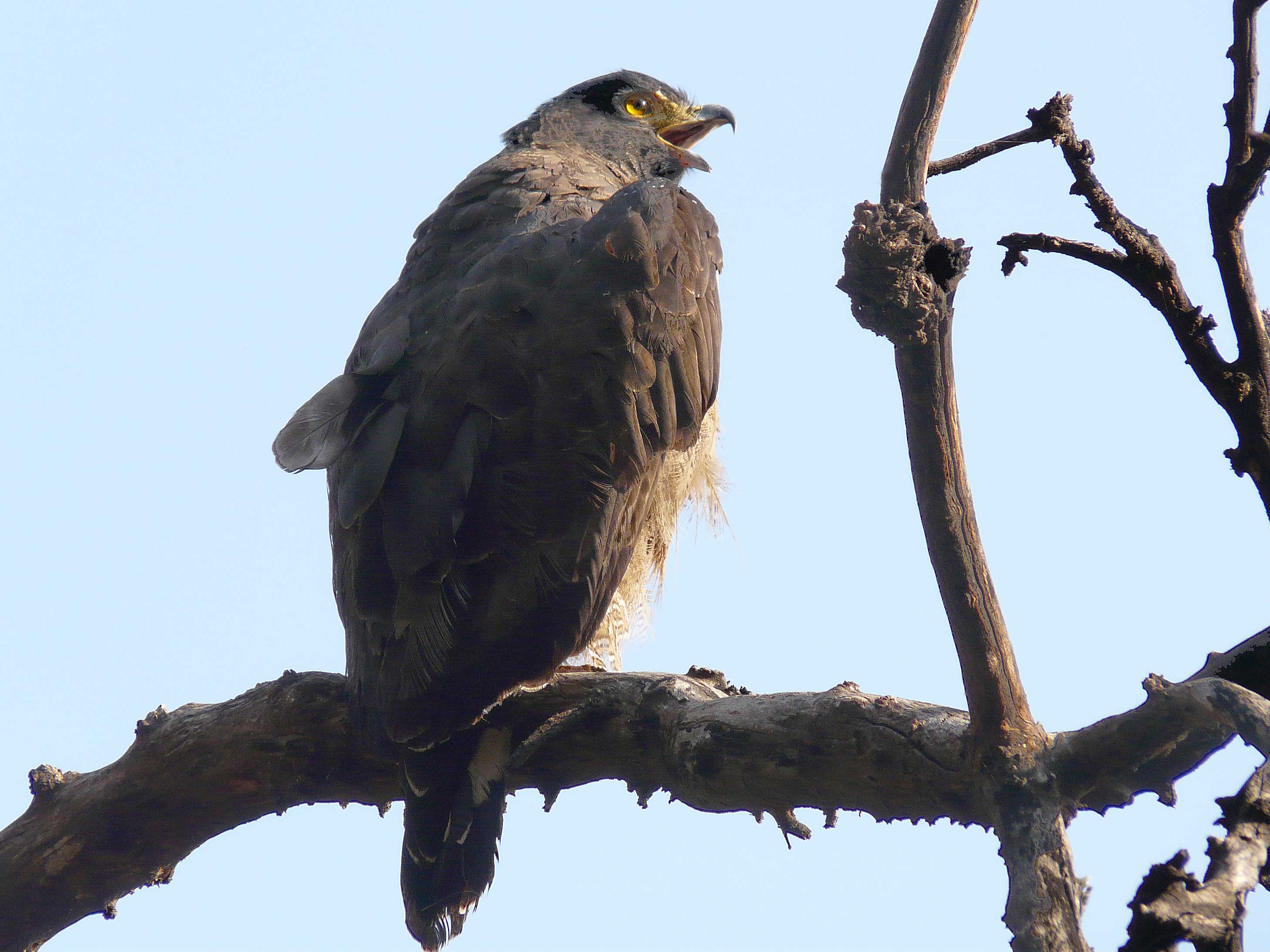
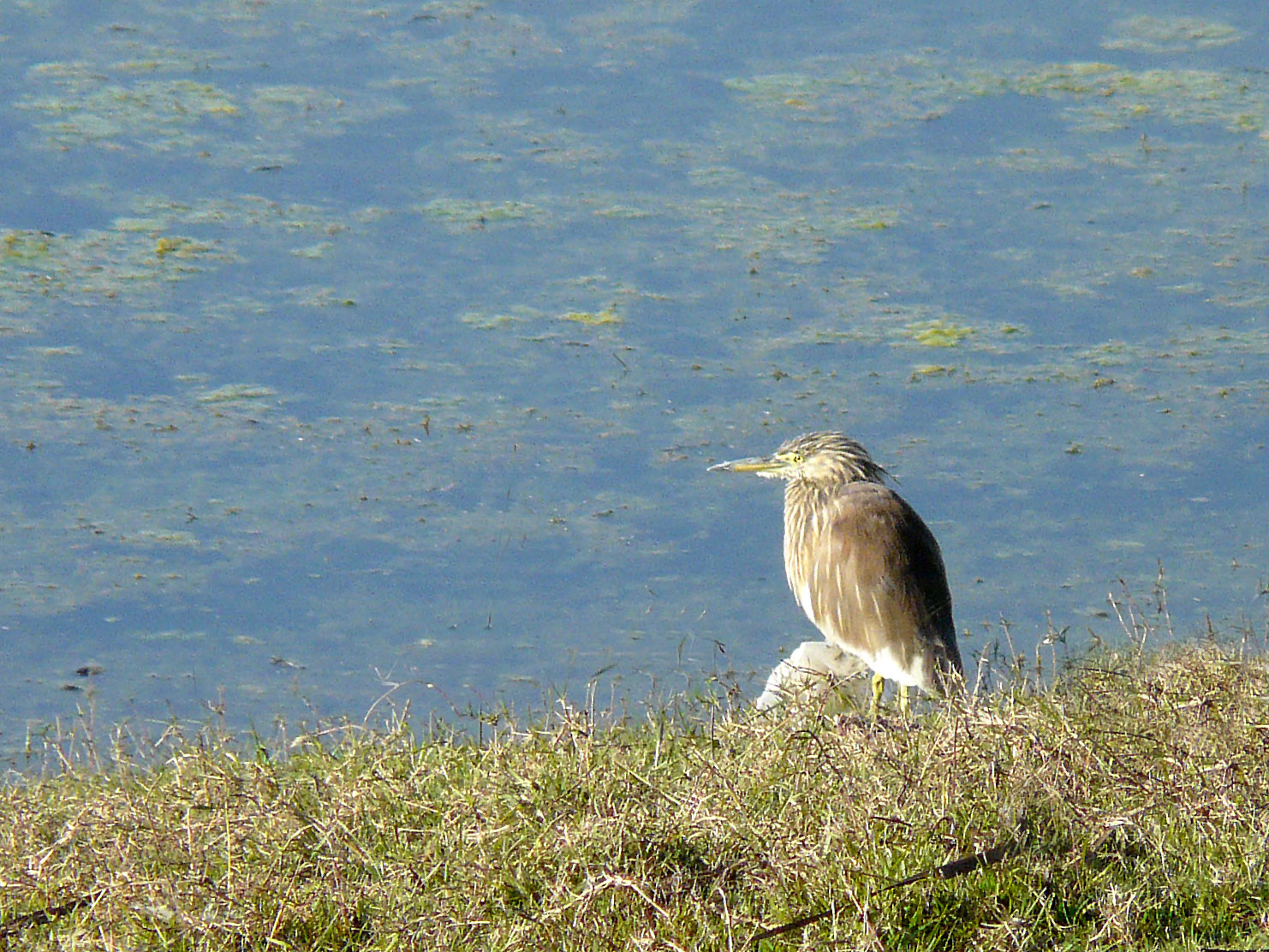
Crested-Serpent-Eagle.
Photo
©
2010
by
Blake
Maybank.
Indian
Pond-Heron.
Photo
©
2010
by
Blake
Maybank.
Day 09 -
February 02, Tuesday: Ranthambhor NP
There were
morning and
afternoon excursions into the park to try again for tigers.
And once again we again failed to see a tiger, though one was heard
(impressive, but hardly satisfying for one's life mammal list).
The mammal highlight was an extended look at a Sloth Bear.
In between the two excursions we climbed up to the top of Ranthambhore
Fort, a fortress that commands a strategic location, 700 feet above the
surrounding plain.
Inside the fort there are three Hindu temples
dedicated to Ganesh, Shiva, and Ramlalaji, and we entered the Ganesh
temple to receive blessings (in honour of our birding guide, Ganesh).
Day List Highlights
(of 108 species in total):
Bar-headed Goose
Comb Duck
Painted Spurfowl
Red-headed Vulture
Crested Serpent-Eagle
Shikra
Great Thick-knee
Yellow-footed Pigeon
Spotted Owlet
Savanna Nightjar
Yellow-crowned Woodpecker
Large Cuckoo-shrike
Common Iora
Gray-breasted Prinia
Jungle Prinia
Plain Prinia
Tickell’s Blue-Flycatcher
Indian Chat
Common Woodshrike
White-bellied Drongo
Chestnut-shouldered Petronia
Plum-headed
Parakeet.
Photo
©
2010
by
Blake
Maybank.
(Asian)
Spotted
Owlet.
Photo © 2010 by Blake Maybank.
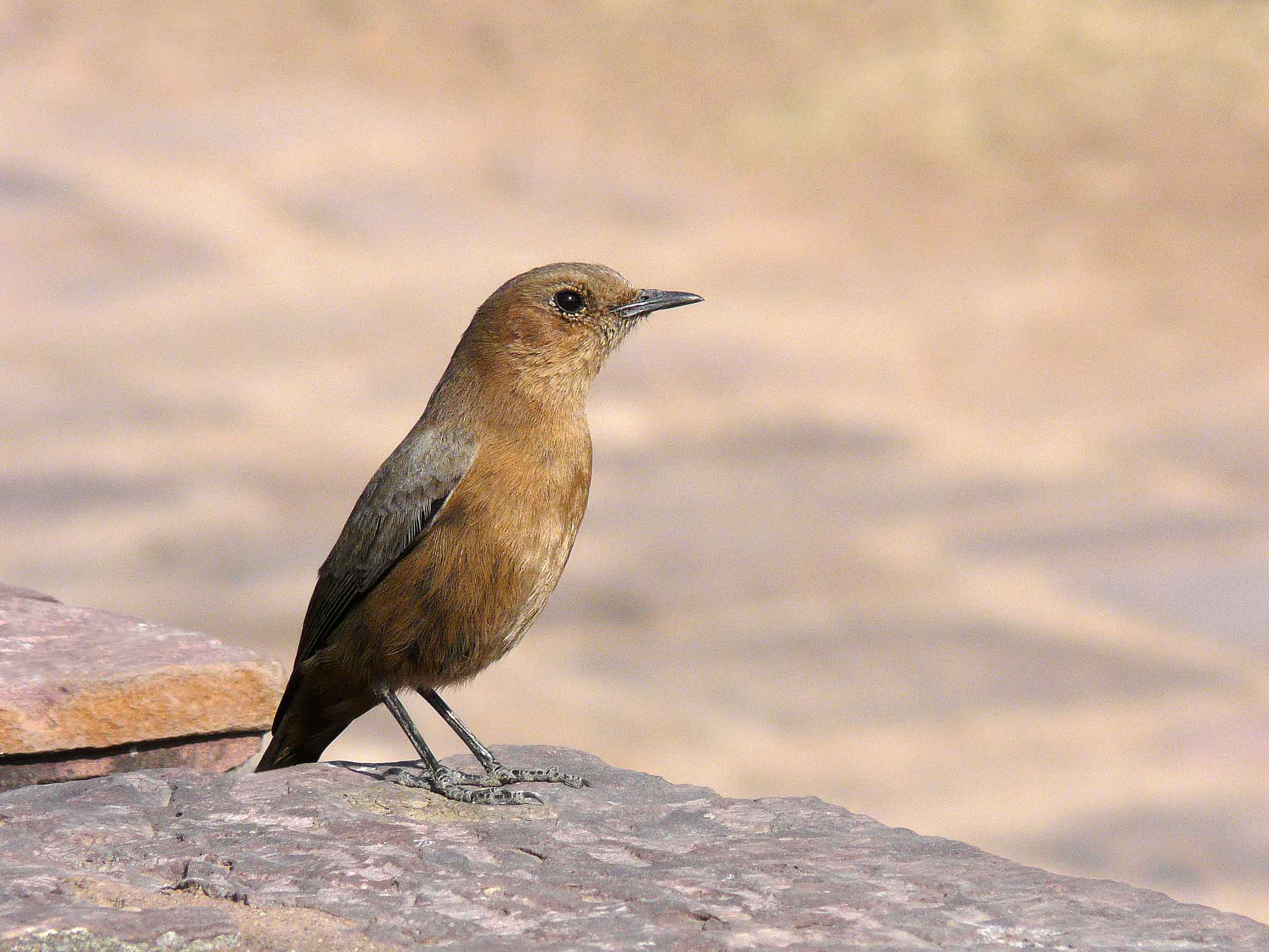
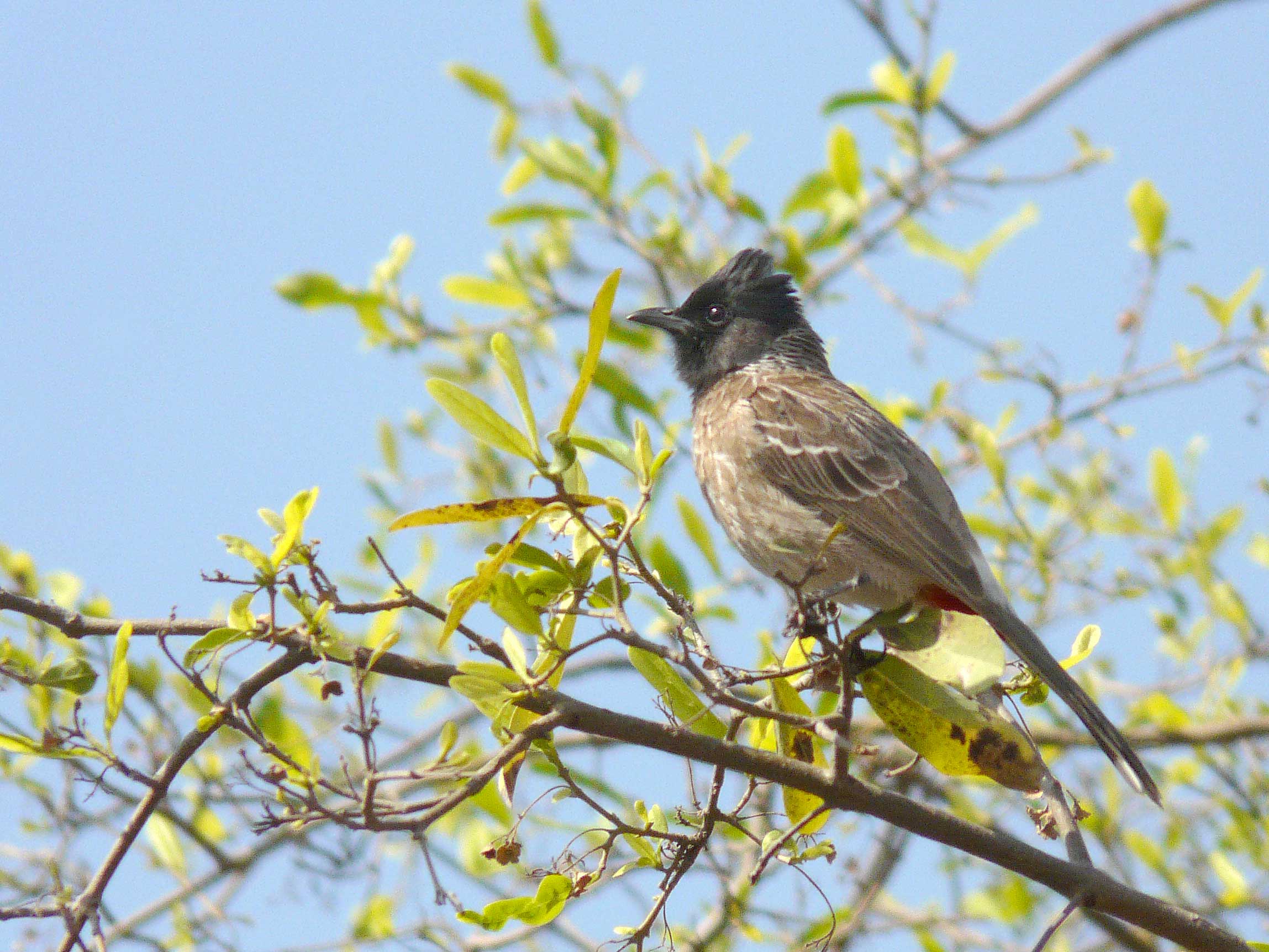 Indian Chat. Photo © 2010 by Blake Maybank.
Red-vented-Bulbul. Photo © 2010 by Blake Maybank.
Indian Chat. Photo © 2010 by Blake Maybank.
Red-vented-Bulbul. Photo © 2010 by Blake Maybank.
Day 10 -
February 03, Wednesday: Ranthambhor NP, and drive to Jaipur
Our last morning in the park, and one last try for tiger.
You can
guess the result. Missing the tiger was our only disappointment
of our visit to Ranthambhor, but we did encounter many mammals, and
plenty of birds (mammal list at the end of Part 3). It is
remarkable how many birds you can see from the back of an open jeep.
The drive to Jaipur was uneventful (though no drive in Indian traffic
is boring), though we managed a bit of birding in disturbed fields
where we had made a random stop, in an attempt to eat our box
lunches. During our drives it was often difficult to locate
convenient rest stops (ie, ones with toilets), but the problem with
this particular stop was that we were quickly surrounded by curious
locals, who materialise out of thin air, it seems. We surrendered
most of the contents of our box lunches to eager children. I
should note that, save for the box lunches, we enjoyed superb food
throughout our trip. Box lunches, however, were invariably very
poor, for reasons that escape me.
Upon our arrival in Jaipur we had time for a little birding around the
grounds of
our hotel, the Hotel Raj Mahal. There was
lots of activity on the hotel grounds, as they were preparing for a
wedding with 5000 guests. The astrologers had decreed a two-week
window for auspicious nuptials, and every hotel in the country seemed
to be booked daily with weddings. This all added to the
flavour of the trip.
Day List Highlights
(of 86 species):
Red-naped Ibis
Barred Buttonquail
Large-billed Crow
Indian Bushlark
Red-breasted Flycatcher
Brahminy Starling (hotel grounds)
Rosy Starling (hotel grounds)
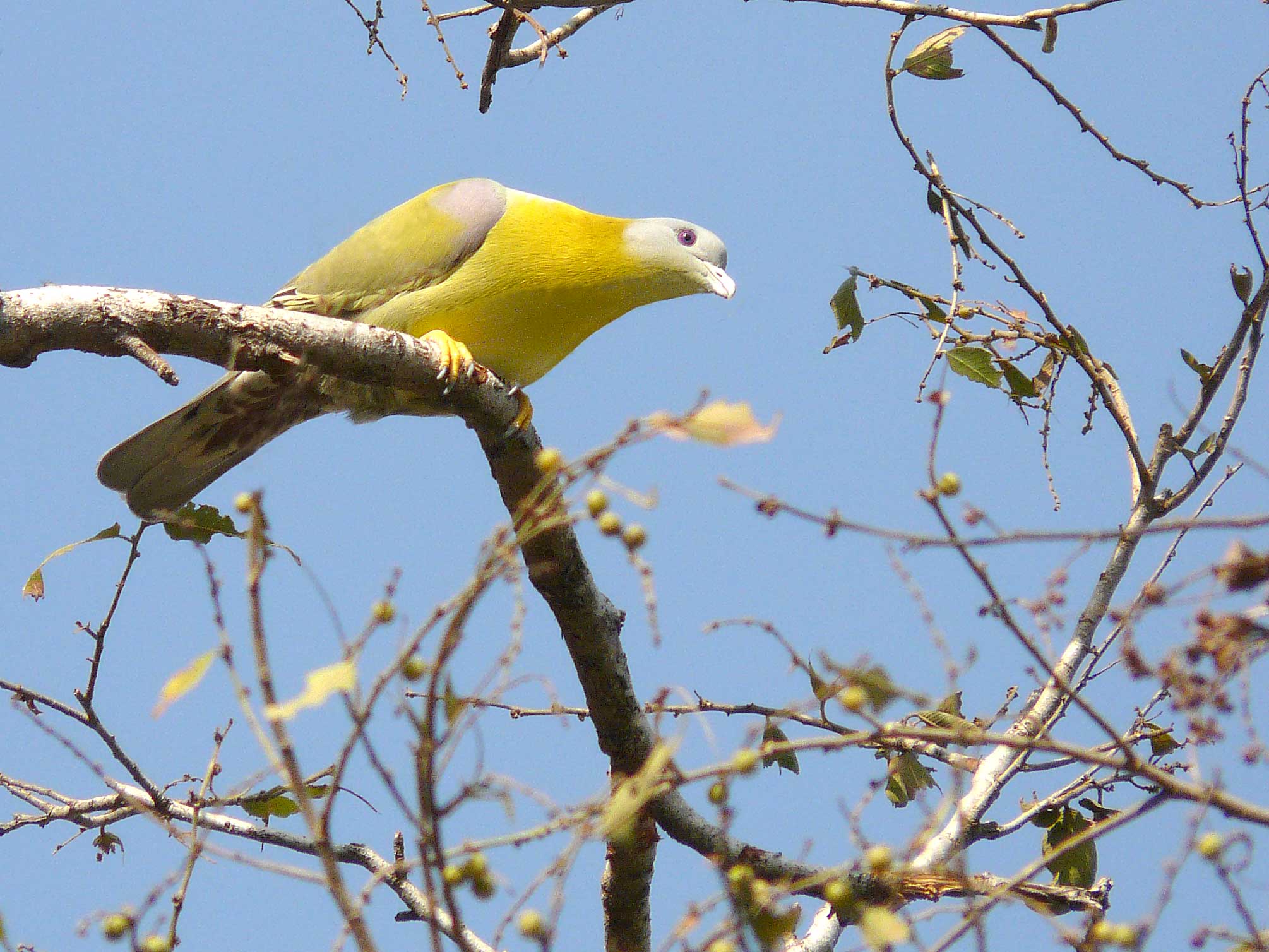
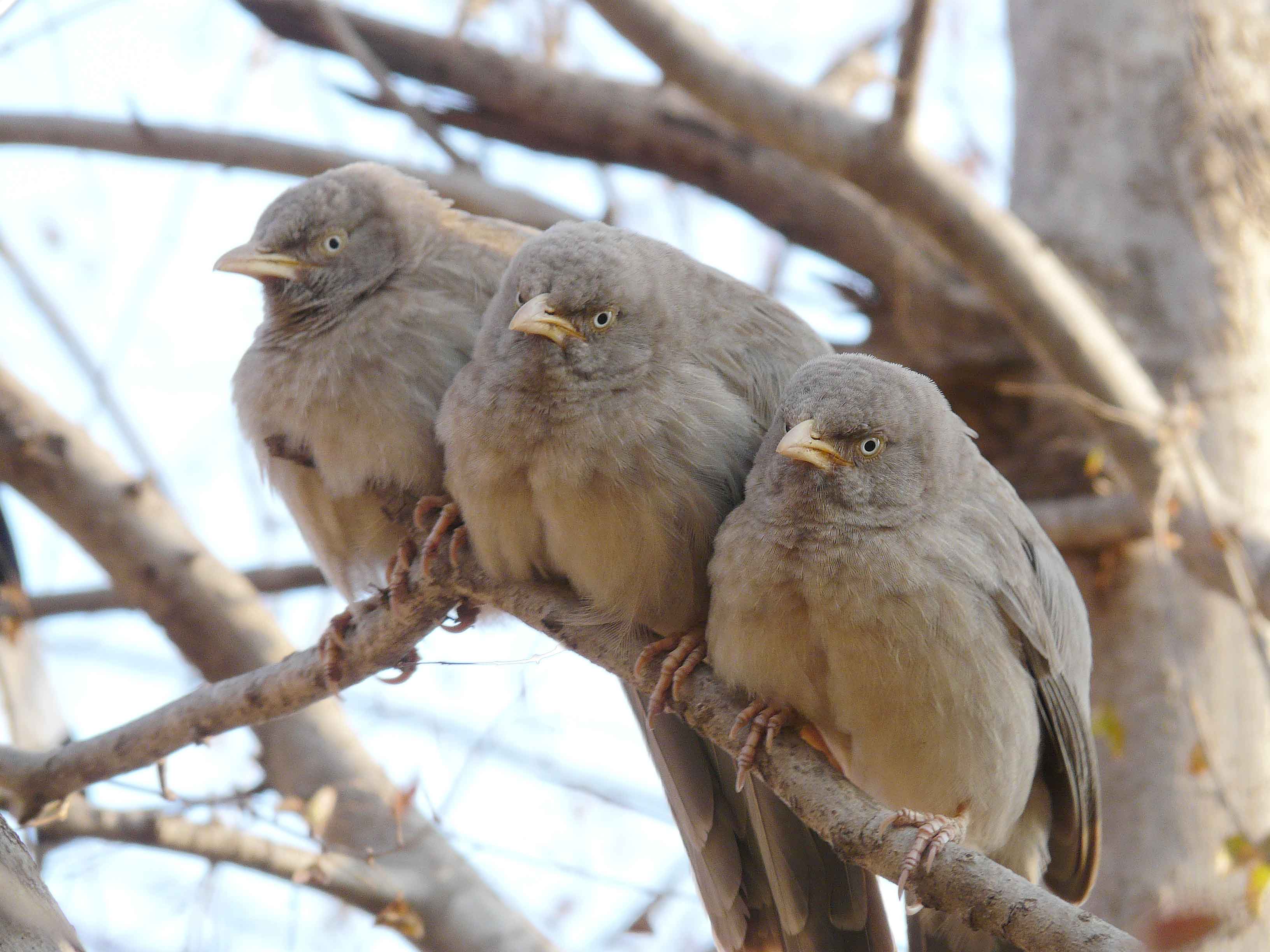
Orange-footed
Pigeon.
Photo
©
2010
by
Blake
Maybank.
Jungle
Babblers.
Photo
©
2010
by
Blake
Maybank.
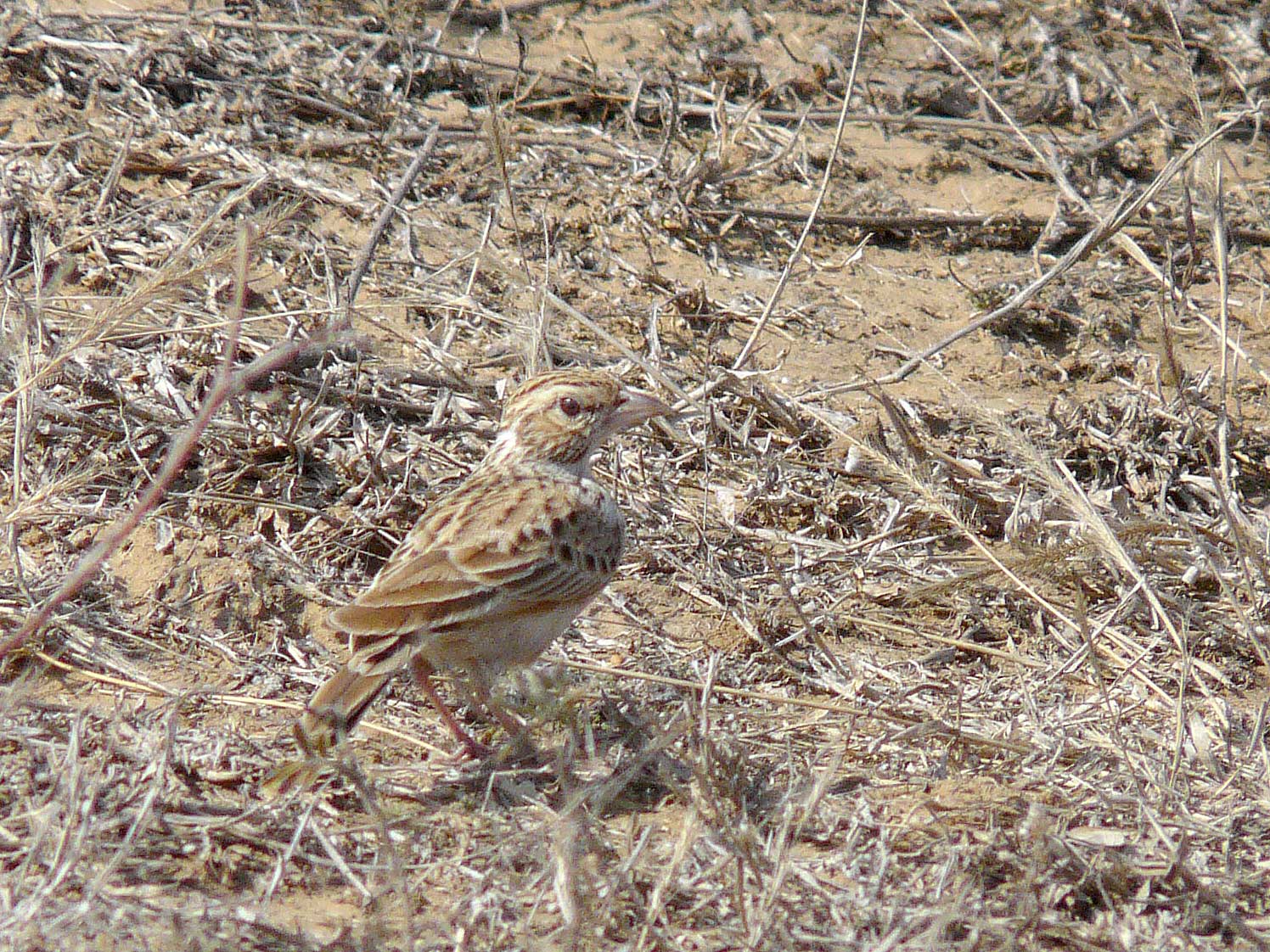
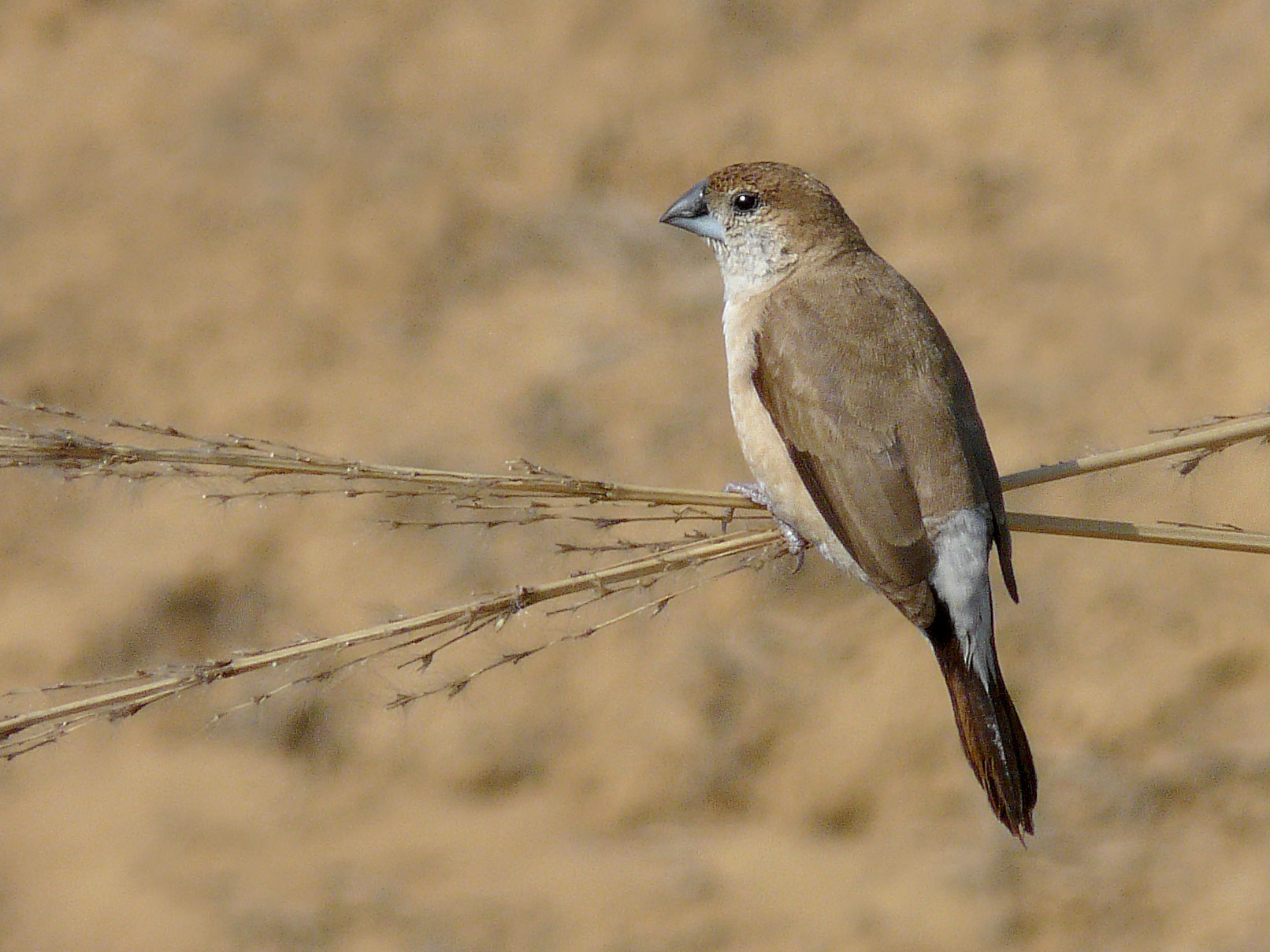 Indian-Bush-Lark. Photo
© 2010 by Blake Maybank.
Indian
Silverbill.
Photo
©
2010
by
Blake
Maybank.
Indian-Bush-Lark. Photo
© 2010 by Blake Maybank.
Indian
Silverbill.
Photo
©
2010
by
Blake
Maybank.
Day 11 -
February 04, Thursday: Jaipur
Before breakfast we checked out the grounds of our hotel, and
could not
help but notice a large flock of Rosy Starlings, investigating the lawn
in the area where preparations were being made for an upcoming wedding.
Flocks of Rosy Starlings on
the Hotel Grounds.
After
breakfast
we
drove
the 11 km to the 17th Century Amber Fortress. We ascended to
the fort via elephant (and without incident). We were immersed in
culture all morning. After lunch we managed a spot of birding
along the productive edge of Mansagar Lake, and this was followed by a
visit to Jantar Mantar, a large stone
observatory. In the late afternoon, for some of the group, there
was some retail therapy.
Day List Highlights
(of 59 species):
Little Grebe
Painted Stork
Eurasian Sparrowhawk
Snowy (Kentish) Plover
Marsh Sandpiper
Little Stint
Asian Koel
Rosy Starling (hundreds at the Hotel)
Jantar
Mantar,
Jaipur.
Astrology
Calculator.
Photo
©
2010
by
Blake
Maybank.
Day 12 -
February 05, Friday: Jaipur to Bharatpur
The entire morning was spent driving to our hotel outside Keoladeo National Park in
Bharatpur. We stayed at the Hotel Kadamb Kunj, which was
adequate for our purposes, and was one of very few options. The
only downside was the noise from the adjacent and busy highway,
especially noticeable at night, when truck traffic seemed to peak.
Our new birding guide was Rataan Singh, older and more experienced than
Ganesh (who was an excellent birder in his own right), and who shared
with Ganesh a remarkable ability to find and point out birds and other
wildlife.
In the afternoon we made a foray into Keoladeo National Park, and I
noticed, once again, what a difference 20 years makes. The park
was almost dry, due to an extended drought, and the illegal (though
tacitly approved) diversion of almost all the water that heretofore had
flowed into the park. All that remained were glorified puddles,
and these held only a tiny fraction of the stunning array of water
birds that greeted us in 1989. And, as well, the western
population of Siberian Cranes was now extinct. And yet it is a
park, and enjoys some degree of protection, and there were birds.
And thanks to our guide Ganesh, and the excellent local guides that
accompanied us, we had a very enjoyable afternoon's birding.
Day List Highlights
(of 100 species)
Black-necked Stork
Short-toed Eagle
Greater Spotted Eagle
Purple Swamphen
Sarus Crane
Yellow-wattled Lapwing
White-tailed Lapwing
Marsh Sandpiper
Wood Sandpiper
Pin-tailed Snipe
Indian Courser
Collared Scops-Owl
Dusky Eagle-Owl
Large-tailed Nightjar
Long-tailed Minivet
Clamorous Reed-Warbler
Western Yellow Wagtail
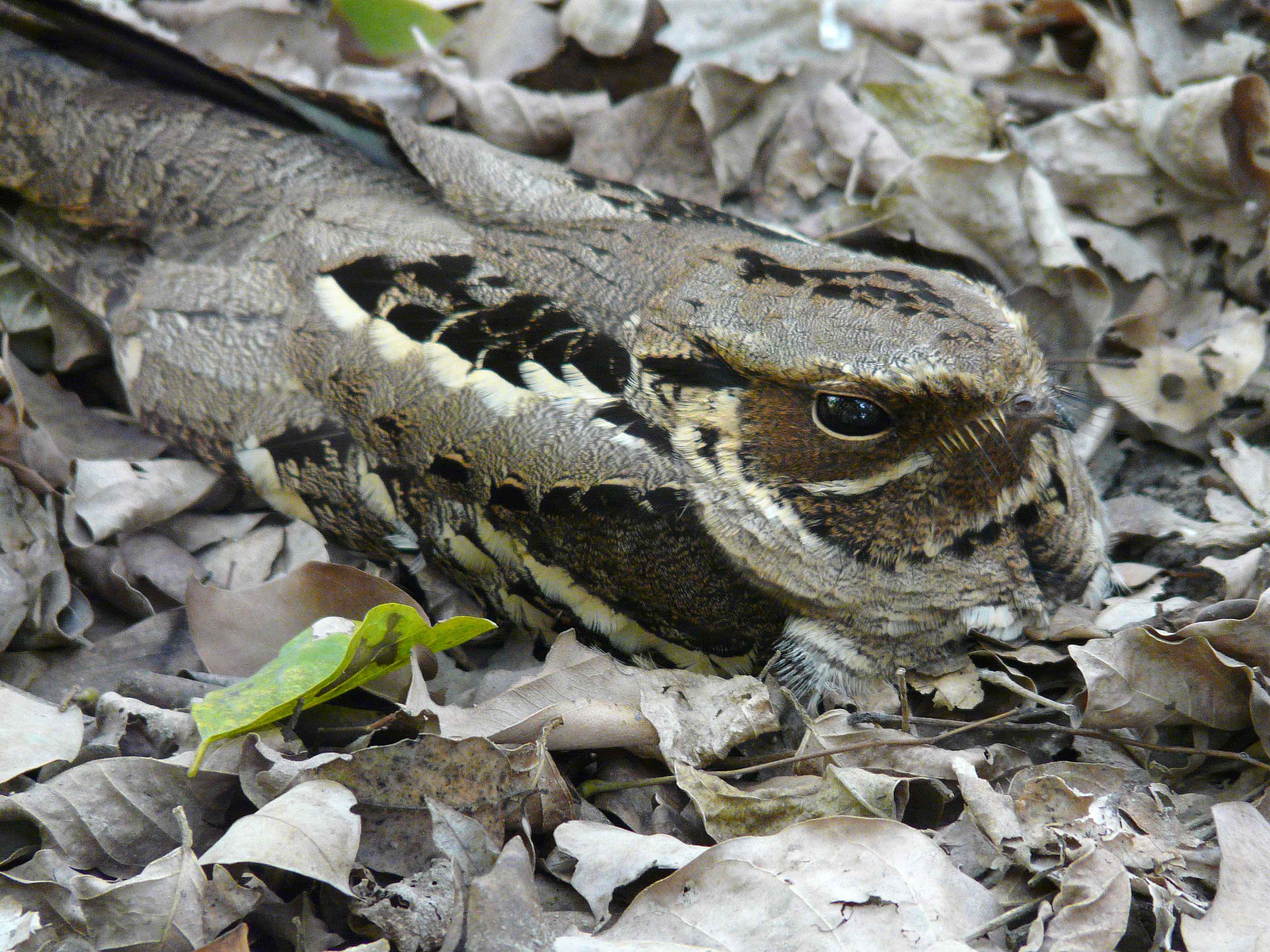
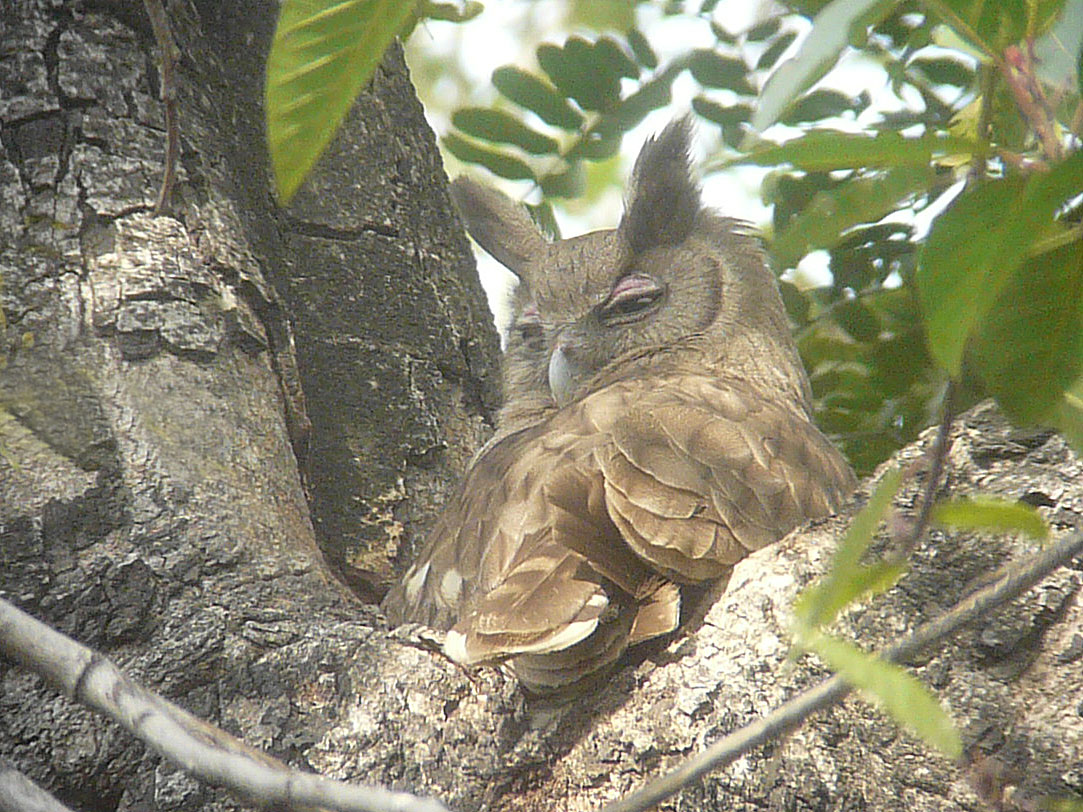 Large-tailed Nightjar. Photo ©
2010 by Blake Maybank.
Dusky Eagle-Owl. Photo © 2010 by Blake Maybank.
Large-tailed Nightjar. Photo ©
2010 by Blake Maybank.
Dusky Eagle-Owl. Photo © 2010 by Blake Maybank.
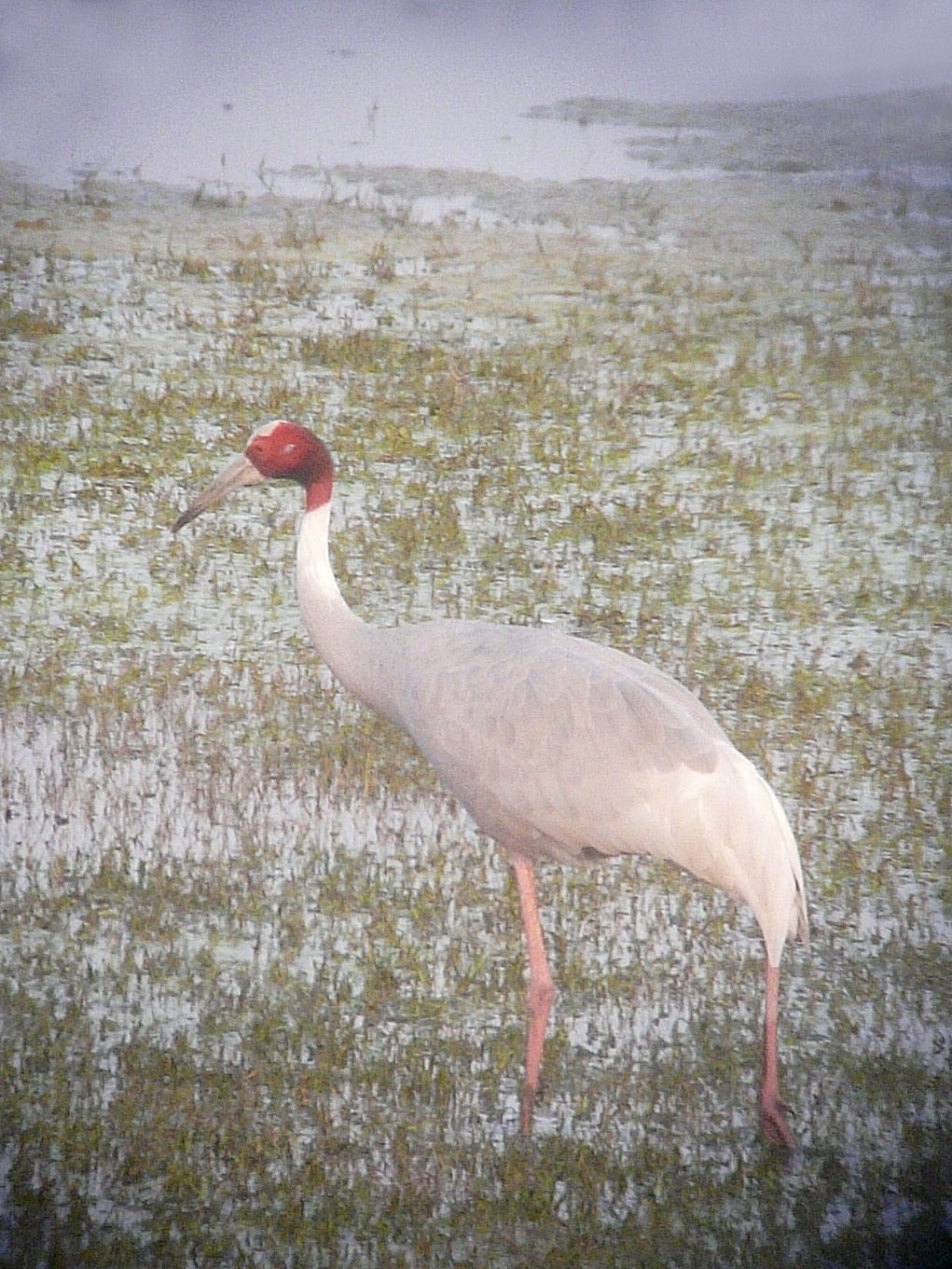 Sarus Crane. Photo © 2010
by Blake Maybank.
Sarus Crane. Photo © 2010
by Blake Maybank.
Day 13 -
February 06, Saturday: Bund Baretha Reservoir & Bharatpur
We drove over rather bumpy roads in the morning to the Bund Baretha
Reservoir. Along the way we stopped at a site with a large group
of roosting Indian Flying Foxes, and there was a Brown Hawk-Owl in the
same copse.
We ventured to the reservoir because we were seeking out water
birds,
since diversity and
numbers were now so restricted at Keoladeo National Park. It was
a wonderful morning, and we lingered until after lunch. In the
afternoon some of the group made a return visit to Keoladeo NP, but
birded
outside the boundary proper this time.
Bund
Baretha.
Water at last. Photo © 2010 by Blake Maybank.
Day List Highlights
(of 127 species) - At or near Bund Baretha except where noted.
Lesser Whistling-Duck
Cotton Pygmy-goose
Garganey
Common Pochard
Ferruginous Duck (20+)
Rock Bush-Quail
Indian Cormorant
Darter
Glossy Ibis
Asian Openbill
Oriental Honey-Buzzard
(Keoladeo National Park)
Montagu’s Harrier
Imperial Eagle
Brown Crake
Bronze-winged Jacana
Jack Snipe (Keoladeo National Park)
Whiskered Tern
Brown Hawk-Owl
Gray Nightjar (Keoladeo National Park)
Ashy-crowned Sparrow-Lark
Blyth’s Reed-Warbler
Eastern Orphean Warbler (Keoladeo National Park)
Yellow-eyed Babbler
Long-billed Pipit (Keoladeo National Park)
Red Avadavat
Bronze-winged
Jacana.
Photo
©
2010
by
Blake
Maybank.
Indian
Cormorants.
Photo
©
2010
by Blake Maybank.
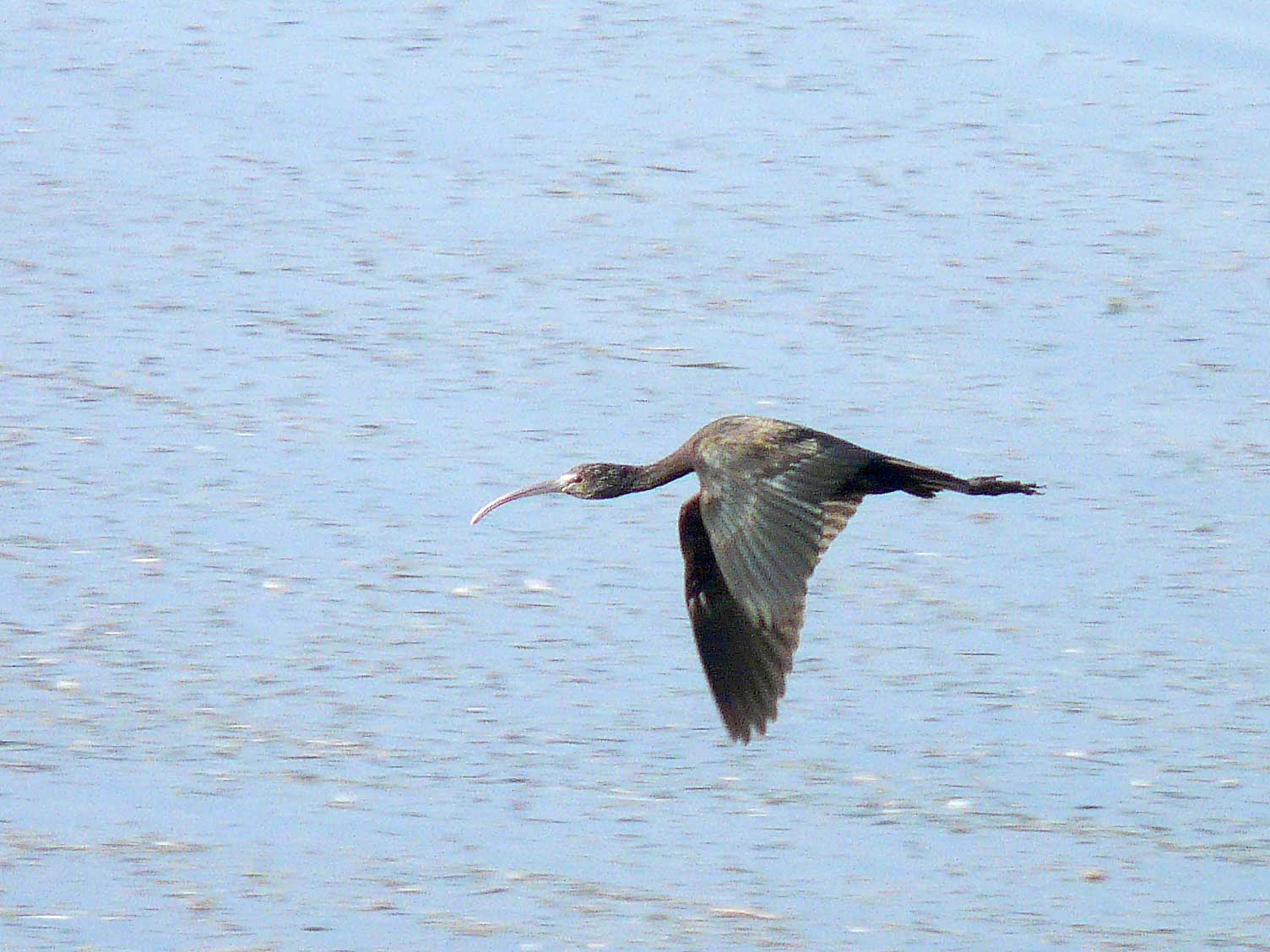
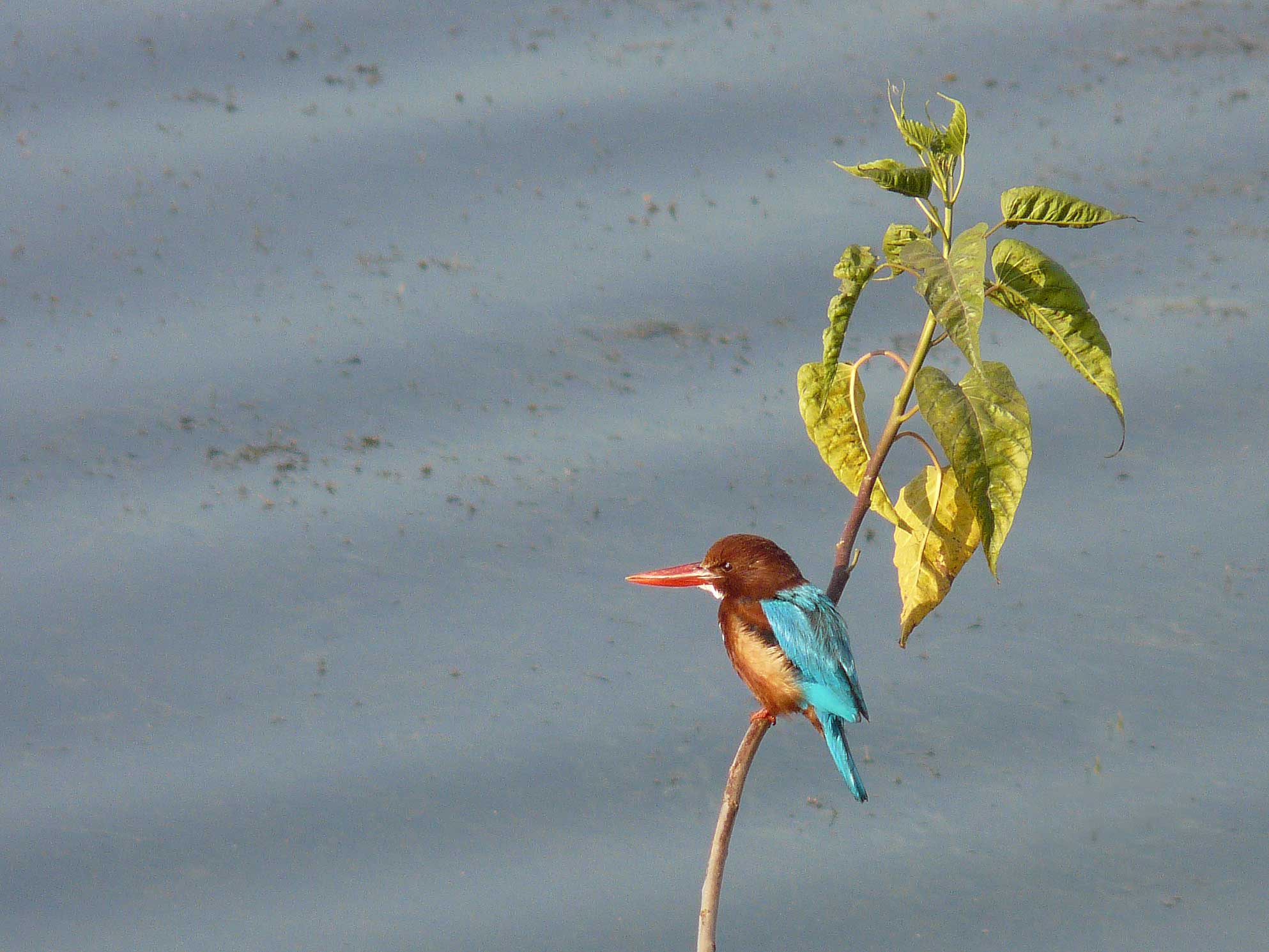
Glossy
Ibis.
Photo
©
2010
by
Blake
Maybank.
White-breasted
Kingfisher.
Photo
©
2010
by
Blake
Maybank.
Day 14 -
February 07, Sunday: Bharatpur to Agra to National Chambal Sanctuary
This was the antithesis of a birding day. This day featured
our
obligatory (and much anticipated) visit to the Taj Mahal. Any birder,
regardless of his or her degree of obsession, who is unmoved by the Taj
Mahal is in serious need of psychological counselling. Our
contracted cultural guide for the day was Sanjay Talan, and while all
our cultural guides on our trip were knowledgeable and professional,
Sanjay was my favourite, with an admirable breadth and depth of
knowledge, an engaging personality, and a willingness to discuss almost
any aspect of Indian life, religion, politics, and people. And he
had great shopping tips, as well. He may be contacted here.
En route to the Taj Mahal we made a brief visit to the Red Fort, and
arrived at the Taj in mid-morning. And so we began our
explorations, alongside hordes of other visitors, most of them
Indian. It might be appropriate at this point to insert a
photograph of the Taj Mahal, but instead I chose the following,
indicating that, regardless of the wonders of the Taj, there is always
time for a spot of birding after the tour.
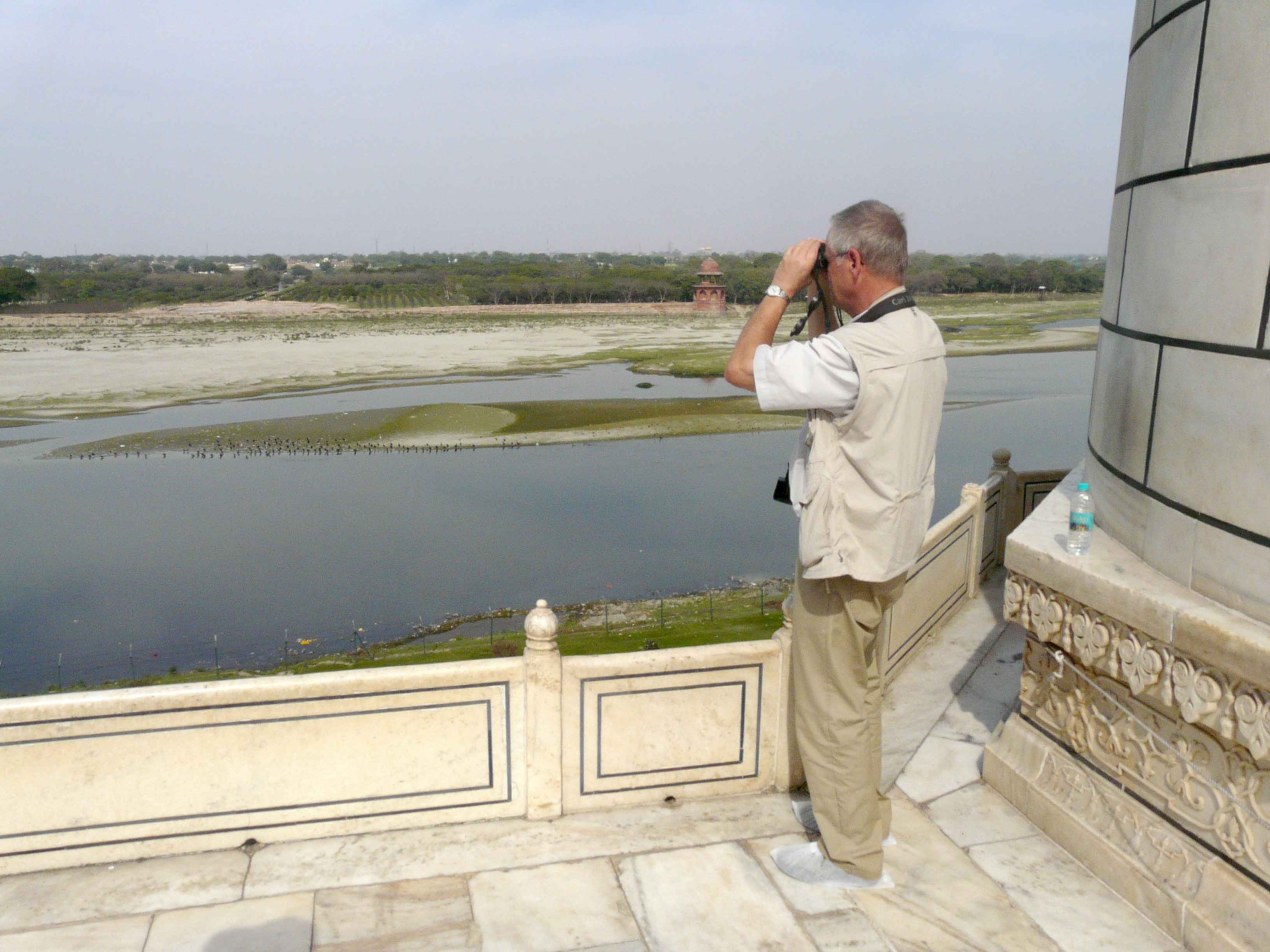
Birding
from
the
Taj
Mahal.
Therapy
required?
Photo
©
2010
by
Blake
Maybank.
We drove in the late
afternoon (after shopping in Agra for marble) to Chambal, where we
spent the night at the Chambal Safari Lodge.
Day List Birding
Highlights
(of 47 species)
Lesser Whistling-Duck
Comb Duck
Red-naped Ibis
Eurasian Hoopoe
Eurasian
Hoopoe.
Photo
©
2010
by
Blake
Maybank.
 Northern
India
Trip
Report
Northern
India
Trip
Report

 Northern
India
Trip
Report
Northern
India
Trip
Report

